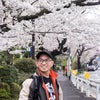Swayambhunath (Devnagari: स्वयम्भूनाथ स्तुप; sometimes romanized Swoyambhunath) is an ancient religious complex atop a hill in the Kathmandu Valley, west of Kathmandu city. It is also known as the Monkey Temple as there are holy monkeys living in parts of the temple in the north-west. The Tibetan name for the site means 'Sublime Trees' (Wylie:Phags.pa Shing.kun), for the many varieties of trees found on the hill. However, Shing.kun may be a corruption of the local Newari name for the complex, Singgu, meaning 'self-sprung'. Swayambhunath is one of the most sacred sites of Buddhist pilgrimage in Nepal, second only to Boudhanath.
We were breathless and sweating as we stumbled up the last steep steps and practically fell upon the biggest vajra (thunder-bolt scepter) that I have ever seen. Behind this vajra was the vast, round, white dome of the stupa, like a full solid skirt, at the top of which were two giant Buddha eyes wisely looking out over the peaceful valley which was just beginning to come alive.
Much of Swayambhunath's iconography comes from the Vajrayana tradition of Tibetan Buddhism. However, the complex is also an important site for Buddhists of many schools, and is also revered by Hindus.
According to Swayambhu Purana, the entire valley was once filled with an enormous lake, out of which grew a lotus. The valley came to be known as Swayambhu, meaning "Self-Created." The name comes from and eternal self-existent flame (Шаблон:IAST) over which a sūpa was later built.
Swayambhunath is also known as the Monkey Temple as there are holy monkeys living in parts of the temple in the north-west. They are holy because Majusri, the bodhisattva of wisdom and learning was raising the hill which the Swayambhunath Temple stands on. He was supposed to leave his hair short but he made it grow long and head lice grew. It is said that the head lice had transformed into these monkeys.
The Bodhisatva Manjushri had a vision of the lotus at Swayambhu and traveled there to worship it. Seeing that the valley can be good settlement and to make the site more accessible to human pilgrims, Manjushri cut a gorge at Chovar. The water drained out of the lake, leaving the valley in which Kathmandu now lies. The lotus was transformed into a hill and the flower become the Swayambhunath stupa.
Swayambhunath, is among the oldest religious sites in Nepal. According to the Шаблон:IAST Swayambhunath was founded by the great-grandfather of King Mānadeva (464-505 CE), Шаблон:IAST, about the beginning of the 5th century CE. This seems to be confirmed by a damaged stone inscription found at the site, which indicates that King Mānadeva ordered work done in 640 CE.
However, Emperor Ashoka is said to have visited the site in the third century BCE and built a temple on the hill which was later destroyed. Legend has it that the Buddha himself visited Swayambhunath and gave teachings there two hundred years earlier.
Although the site is considered Buddhist, the place is revered by both Buddhists and Hindus. Numerous king Hindu followers are known to have paid their homage to the temple, including Pratap Malla, the powerful king of Kantipur, who is responsible for the construction of the eastern stairway in the 17th century - as 85% of Nepal's population followers of Hinduism. It is also the official religion of Nepal.
The stupa consists of a dome at the base. Above the dome, there is a cubical structure present with eyes of Buddha looking in all four directions with the word "unity" in the main Nepali dialect between them. There are pentagonal Toran present above each of the four sides with statues engraved in them. Behind and above the torana there are thirteen tiers. Above all the tiers, there is a small space above which the Gajur is present.
The dome at the base represents the entire world. When a person awakes (represented by eyes of wisdom and compassion) from the bonds of the world, the person reaches the state a bit higher. The thirteen pinacles on the top of it symbolises that sensient beings have to go through the thirteen stages of enlightenment to reach Buddhahood.
On each of the four sides of the main stupa there are a pair of big eyes which represent Wisdom and Compassion. Above each pair of eyes is another eye, the third eye. Saying goes that when Buddha preaches, cosmic rays emanate from the third eye which acts as message to heavenly beings, so that those interested can come down to earth to listen to the Buddha. The hellish beings and beings below the human realm cannot come to earth to listen to the Buddha's teaching, however, the cosmic ray relieves their suffering when Buddha preaches.
There are carving of Panch Buddhas (five Buddhas) on each of the four sides of stupa. Apart from this, idols of the Buddhas are at the base of the stupas. Panch Buddhas are Buddha in metaforical sense in Tantrayana. They are Vairochana (occupies the center and is the master of the temple), Akshobhya (faces the east and represents the cosmic element of consciousness), Ratna Sambhava (faces the south and represents the cosmic element of sensation), Amitabha (He represents cosmic element of Sanjna (name) and always faces the West) and Amoghsiddhi (He represents the cosmic element of conformation and faces the north).
Each morning before dawn, hundreds of Buddhist (Vajrayana) and Hindu pilgrims ascend the 365 steps from eastern side that lead up the hill, passing the gilded Vajra (Tibetan: Dorje) and two lions guarding the entrance, and begin a series of clockwise circumambulations of the stupa.





